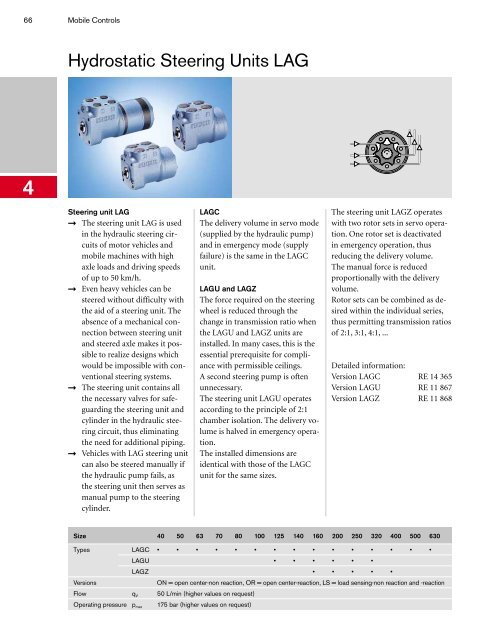Program Information Mobile Hydraulics, Mobile ... - ERGOVIAL
Program Information Mobile Hydraulics, Mobile ... - ERGOVIAL
Program Information Mobile Hydraulics, Mobile ... - ERGOVIAL
You also want an ePaper? Increase the reach of your titles
YUMPU automatically turns print PDFs into web optimized ePapers that Google loves.
66 <strong>Mobile</strong> Controls<br />
4<br />
Hydrostatic Steering Units LAG<br />
Steering unit LAG<br />
U The steering unit LAG is used<br />
in the hydraulic steering circuits<br />
of motor vehicles and<br />
mobile machines with high<br />
axle loads and driving speeds<br />
of up to 50 km/h.<br />
U Even heavy vehicles can be<br />
steered without difficulty with<br />
the aid of a steering unit. The<br />
absence of a mechanical connection<br />
between steering unit<br />
and steered axle makes it possible<br />
to realize designs which<br />
would be impossible with conventional<br />
steering systems.<br />
U The steering unit contains all<br />
the necessary valves for safeguarding<br />
the steering unit and<br />
cylinder in the hydraulic steering<br />
circuit, thus eliminating<br />
the need for additional piping.<br />
U Vehicles with LAG steering unit<br />
can also be steered manually if<br />
the hydraulic pump fails, as<br />
the steering unit then serves as<br />
manual pump to the steering<br />
cylinder.<br />
LAGC<br />
The delivery volume in servo mode<br />
(supplied by the hydraulic pump)<br />
and in emergency mode (supply<br />
failure) is the same in the LAGC<br />
unit.<br />
LAGU and LAGZ<br />
The force required on the steering<br />
wheel is reduced through the<br />
change in transmission ratio when<br />
the LAGU and LAGZ units are<br />
installed. In many cases, this is the<br />
essential prerequisite for compliance<br />
with permissible ceilings.<br />
A second steering pump is often<br />
unnecessary.<br />
The steering unit LAGU operates<br />
according to the principle of 2:1<br />
chamber isolation. The delivery volume<br />
is halved in emergency operation.<br />
The installed dimensions are<br />
identical with those of the LAGC<br />
unit for the same sizes.<br />
The steering unit LAGZ operates<br />
with two rotor sets in servo operation.<br />
One rotor set is deactivated<br />
in emergency operation, thus<br />
reducing the delivery volume.<br />
The manual force is reduced<br />
proportionally with the delivery<br />
volume.<br />
Rotor sets can be combined as desired<br />
within the individual series,<br />
thus permitting transmission ratios<br />
of 2:1, 3:1, 4:1, ...<br />
Detailed information:<br />
Version LAGC RE 14 365<br />
Version LAGU RE 11 867<br />
Version LAGZ RE 11 868<br />
Size 40 50 63 70 80 100 125 140 160 200 250 320 400 500 630<br />
Types LAGC • • • • • • • • • • • • • • •<br />
LA GU • • • • • •<br />
LA GZ • • • • •<br />
Versions ON = open center-non reaction, OR = open center-reaction, LS = load sensing-non reaction and -reaction<br />
Flow qV 50 L/min (higher values on request)<br />
Operating pressure pmax 175 bar (higher values on request)



